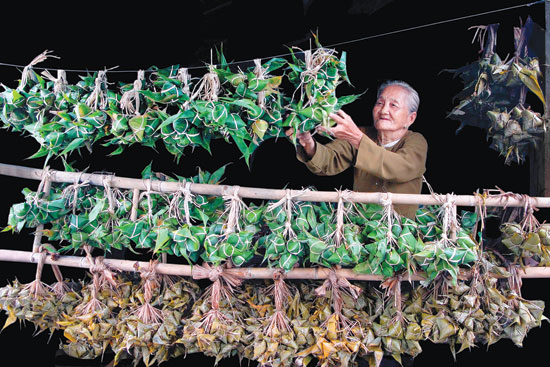No 3, Vol.8 ,July – August 2015
Selling bánh ú in T?t ?oan Ng?, Ho Chi Minh City. Photo: Kim Chi
Tearing a page from the calendar hanging on the wall, my mum said ‘Time passes so fast. T?t ?oan Ng? is approaching.’ It means it has been half a year since Tet holiday. T?t ?oan Ng?, or Double Fifth Festival, is held on the fifth day of the fifth month on the lunar calendar. The festival takes place in Vietnam, China and Korea. However, every country has different origins and their own features.
T?t ?oan Ng? is also called T?t ?oan D??ng. ‘?oan’ is beginning. ‘Ng?’ means noon. ‘D??ng’ is sun. ‘?oan D??ng’ means the hottest period of the year. T?t ?oan Ng? is an occasion for people to worship and mark a new season bringing bright and peaceful days. 
A bundle of leaves hanging in front of the house in the festival. Photo: Tu Anh
My family celebrates this festival every year, but I do not know the origin of the festival. I only know the festival is not any less exciting than Tet. Moreover, I can enjoy bánh ú or bánh bá tr?ng and bánh tro or bánh gio, specialties in the festival. I and my mother go to the market early to buy fruit, flowers and bánh ú for worshiping gods and ancestors, and a bundle of leaves to hang in front of the house, which is believed to chase away ghosts and other unlucky things. In this day, the market is more crowded than ordinary days. It is full of stacks of bánh ú and different kinds of leaves and the noisy cries of sellers.
Ingredients for making bánh tro. Photo: Tu Anh
Bánh tro is made of glutinous rice, which is soaked in ash water one night, and beans mixed with sugar. Then they are covered with bamboo leaves or dong leaves and boiled. Bánh bá tr?ng is made of glutinous rice, peanut, shiitake mushroom, bean, salted egg, pork and dried shrimp. They are covered by banana leaves or dong leaves and then boiled. Bánh tro and bánh bá tr?ng have a small and large pyramid shape, respectively.
In Vietnam, T?t ?oan Ng? is also called ‘T?t N?a N?m’ (Mid-Year Festival) or ‘T?t Gi?t Sâu B?’ (Parasite-Killing Festival). I wonder why it is called ‘T?t N?a N?m’ when the festival just falls in the fifth month of the year. In ‘Lai Ban Ve Nguon Goc Tet Doan Ngo’, Nguyen Ngoc Tho wrote that ‘In ancient times, Vietnamese used the Kien Ty calendar. The eleventh month of the year is considered as the starting time of a new year. So, the fifth month will fall in the period of a half year. Besides, there is another legend explaining the origin of T?t ?oan Ng?. One day, farmers had a headache because the crops were attacked by harmful insects. Suddenly, a man appeared and taught the farmers that every household should prepare bánh tro and fruit for worshipping then go to their courtyard and do exercise. Every one obeyed his words and soon, all the insects fell out and ran away to the fields. He added that the insects became more ferocious in that day every year. If people obeyed what he instructed the people would be able to handle them. After that the old man disappeared. To commemorate the event, people named that day ‘T?t Di?t Sâu B?’. Some called it T?t ?oan Ng? because the worship happened at noon.
T?t ?oan Ng? is an occasion for members of the family togather and have a meal together. There are different dishes and activities in many places. In Hanoi, ‘S?a chua n?p c?m’ (yogurt with black glutinous rice) is a very popular dish. Many people believe that worms hide deeply in the digestive parts of humans. They will emerge on the fifth day of the fifth month, so people will kill them by eating sour fruit and yogurt with black glutinous rice, and drinking rice wine. In Central and South Vietnam, people usually cook bánh tro and bánh bá tr?ng. A friend said that it is not a good day for ducks because duck is also a favourite dish in that day.n

